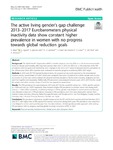Mostrar o rexistro simple do ítem
The active living gender’s gap challenge: 2013–2017 Eurobarometers physical inactivity data show constant higher prevalence in women with no progress towards global reduction goals
| dc.contributor.author | Mayo, Xián | |
| dc.contributor.author | Liguori, Gary | |
| dc.contributor.author | Iglesias-Soler, Eliseo | |
| dc.contributor.author | Copeland, R. J. | |
| dc.contributor.author | Clavel San Emeterio, Iván | |
| dc.contributor.author | Lowe, A. | |
| dc.contributor.author | Villar, Fernando del | |
| dc.contributor.author | Jiménez, Alfonso | |
| dc.date.accessioned | 2020-01-09T15:50:27Z | |
| dc.date.available | 2020-01-09T15:50:27Z | |
| dc.date.issued | 2019-12-12 | |
| dc.identifier.issn | 1471-2458 | |
| dc.identifier.uri | http://hdl.handle.net/2183/24592 | |
| dc.description.abstract | [Abstract]: Background: The World Health Organization (WHO) considers physical inactivity (PIA) as a critical noncommunicable factor for disease and mortality, affecting more women than men. In 2013, the WHO set a 10% reduction of the PIA prevalence, with the goal to be reached by 2025. Changes in the 2013–2017 period of physical inactivity prevalence in the 28 European Union (EU) countries were evaluated to track the progress in achieving WHO 2025 target. Methods: In 2013 and 2017 EU Special Eurobarometers, the physical activity levels reported by the International Physical Activity Questionnaire of 53,607 adults were analyzed. Data were considered as a whole sample and countryby-country. A χ2 test was used to analyze the physical inactivity prevalence (%) between countries, analyzing women and men together and separately. Additionally, PIA prevalence was analyzed between years (2013–2017) for the overall EU sample and within-country using a Z-Score for two population proportions. Results: The PIA prevalence increased between 2013 and 2017 for the overall EU sample (p < 0.001), and for women (p = 0.04) and men (p < 0.001) separately. Data showed a higher PIA prevalence in women versus men during both years (p < 0.001). When separately considering changes in PIA by gender, only Belgium’s women and Luxembourg’s men showed a reduction in PIA prevalence. Increases in PIA prevalence over time were observed in women from Austria, Croatia, Germany, Lithuania, Malta, Portugal, Romania, and Slovakia and in men from Bulgaria, Croatia, Czechia, Germany, Italy, Lithuania, Portugal, Romania, Slovakia, and Spain. Conclusions: PIA prevalence showed an overall increase across the EU and for both women and men between 2013 and 2017, with higher rates of PIA reported for women versus men during both years. PIA prevalence was reduced in only Belgium’s women and Luxembourg’s men. Our data indicate a limited gender-sensible approach while tacking PIA prevalence with no progress reaching global voluntary reductions of PIA for 2025. | es_ES |
| dc.language.iso | eng | es_ES |
| dc.publisher | BMC | es_ES |
| dc.relation.uri | https://doi.org/10.1186/s12889-019-8039-8 | es_ES |
| dc.rights | Atribución 4.0 España | es_ES |
| dc.rights.uri | http://creativecommons.org/licenses/by/4.0/es/ | * |
| dc.subject | Physical inactivity | es_ES |
| dc.subject | Eurobarometer | es_ES |
| dc.subject | Global action plan | es_ES |
| dc.subject | European Union | es_ES |
| dc.title | The active living gender’s gap challenge: 2013–2017 Eurobarometers physical inactivity data show constant higher prevalence in women with no progress towards global reduction goals | es_ES |
| dc.type | info:eu-repo/semantics/article | es_ES |
| dc.rights.access | info:eu-repo/semantics/openAccess | es_ES |
| UDC.journalTitle | BMC public health | es_ES |
| UDC.volume | 19 | es_ES |
| UDC.issue | 1 | es_ES |
| UDC.startPage | 1677 | es_ES |
Ficheiros no ítem
Este ítem aparece na(s) seguinte(s) colección(s)
-
GI-PHG - Artigos [70]






